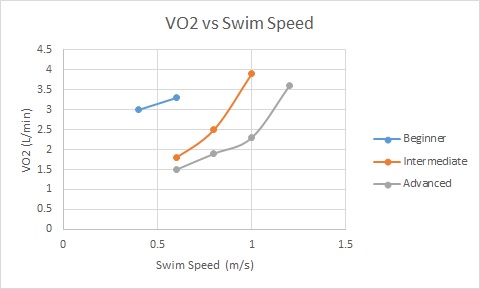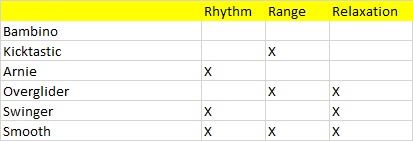Diagnosing & Treating Your Swim Limiter: Part 2
Alan Couzens, MS (Sports Science)
August 25, 2014
 In my last post, I gave an introduction to the 3 key technical swim limiters that I see among triathletes. Namely, Rhythm, Range and Relaxation. I suggested that,
if you are serious about improving your swim this season, that it is essential to identify which of these are holding you back. Finally, I pointed your over to
Swim Smooth for a simple but powerful 'diagnostic' tool to begin to identify your current limiter.
In my last post, I gave an introduction to the 3 key technical swim limiters that I see among triathletes. Namely, Rhythm, Range and Relaxation. I suggested that,
if you are serious about improving your swim this season, that it is essential to identify which of these are holding you back. Finally, I pointed your over to
Swim Smooth for a simple but powerful 'diagnostic' tool to begin to identify your current limiter.
In this article, I'm going to delve a little more into the practicalities of how to go about diagnosing your own swim limiter. I'll introduce you to a simple test that you can use to not only help to identify your own weaknesses but also to help you track improvement in these areas over time.
Before we get into the fun stuff, a quick story that will help to better illustrate some of the principles of improving your limiter. The guy above is Michael Klim. Klim was also training at the Australian Institute of Sport with Alex Popov during my stay. At the time, Klim was still a relatively young guy and an 'up and comer' on the Aussie swim scene. I had seen him swim a few times before at various meets and his stroke 'looked' like most of the other top Aussies at the time, i.e. very 'rangey' with a heavy kick. At that time, he was a very good flyer and a fair 200 freestyler. However, the first time that I saw him at the A.I.S., I saw a very different swimmer. Long gone was the semi catch up, heavy kick stroke and in its place was a strong, very pull dominant power stroke. Gennadi had taken one look at Klim when he arrived at the A.I.S. and decided that as a strong, muscular guy, his stroke was not geared to his strength & so, after identifying that limiter, he completely rebuilt it around the power stroke to which Klim was most naturally suited and Klim became a truly world class sprinter who often rivaled the (very different) smooth stroking Alexander. The moral of the story is that a lot of good can come from training against preference and exploring the weaker areas of your stroke. Who knows, what you thought was a weakness may actually turn out to be a natural strength!
Below you'll find a diagnostic tool to help you better identify your own limiter. It's based on a couple of very simple but important relationships that we see between patterns in speed and stroke length as explained below...
1. The relationship between an increase in effort and an increase in speed
There is an interesting pattern related to the skill level of a swimmer that was first identified by Holmer way back in the 70's. That pattern is this...
If we look at the energy expenditure of skilled and unskilled swimmers, not only do we see skilled swimmers expend less energy for a given speed but also the rate of change in energy expenditure for a given pace increase is significantly less.
This relationship (with the actual data from that study) is shown in the chart below...

As you can see, for a given increase in energy output (VO2), the skilled swimmer gets a lot more speed 'bang' for their energy 'buck'. This is due to a very basic rule of hyrdrodynamics - the faster you go, the more drag increases (exponentially) and the more impact a poor technique will have. Knowing the above, if we test 2 or more effort levels and we monitor the pace jump between these levels, it can tell us a lot about the skill level of the swimmer.
2. The relationship between an increase in effort and an increase in stroke count
Similarly, the way that stroke count changes with increasing effort, tells us a lot about the 'type' of swimmer that we are working with. Whether they are able to..
- Significantly increase pace while holding stroke count
- Hold stroke count but only marginally increase speed
- Significantly increase speed but with an also equally increased stroke count
- Significantly increase stroke count without it doing a lot for speed
- Marginally increase speed but with a decreased stroke count (It does actually happen!)
This relationship tells the savvy coach a lot about relative pull v kick dominance, along with potential strengths, weaknesses and the most advantageous technical areas of immediate focus
If we put these 2 simple metrics together, we have a plethora of good information to help us better understand the strengths and weaknesses of any swimmer
So let's get down to the fun stuff! You may have seen the training zone calculator that I recently added to the EC site. In that article I outlined my preferred method of identifying swim zones - via a narrow descend 5x400m set (from easy to moderate). With a slight modification, this set can also tell us a lot about the technical elements of the swimmer -- their swim type and also their relative strengths and weaknesses across the '3 Rs'.
Below, you'll find a calculator based on that 5x400m set. To use it, simply plug in your height (in cm), your best 5 min bike power (from a recent test) along with the pace and stroke count data from the 400's that best line up with the resp. heart rate zones....
The calculator will do some 'behind the scenes' math to look at the relationship between your increase in pace (with an increase in physiological effort) along with any increase or decrease in stroke length for a given physiological effort to better quantify your own rhythm, range and relaxation in the water. It will then spit out a ranking (out of 10) for each, shown on the bar chart below
Relaxation0
Range
Rhythm0
Overall Swim Score: 0/30
How to interpret the test
If you score below 7 in any of the 3, consider it a potential limiter worthy of some attention. You may find that you have more than one limiter under the 7 mark. This simply indicates that you have a lot of upside on the technical side of things & will benefit quickly from a dedicated technical focus block! On the flipside, if you're 'high and balanced' across all 3, bad news for you: Your route to improvement is fitness, in other words - YARDS! :-) For additional context, and a bit of a clue on where this is headed for each of the limiters, you can then refer back to my take on how these limiters tie in to Swim Smooth's swimtypes

This algorithm is just a high tech version of the old 'swim golf' game -- where you take your speed and your stroke count and add them together for a total score. While that concept is a useful one, the weighting isn't fair and can lead to some suboptimal messages regarding optimal technique. E.g. A normal 25m sprint for me might be 14s and 15 strokes for a score of 29 but if I kick a 25 hard on my side and don't take any strokes, I could pretty comfortable do it in 22s or so, leading to a score of 22+0 = 22!. While this is an extreme example, you can see the danger in putting too much emphasis on this (non weighted) metric
Once you are aware of (& able to somewhat quantify) your limiters, you can have a much more focused plan of attack to the technical aspect of your swim training. Rather than having a myriad of drills that may or may not work against your limiter, you can stick to a handful of drills that are specifically designed to address your personal weakpoints. Furthermore, you can use the calculator above to help to better quantify whether you're improving and in what direction you're improving. Sometimes it's a bit like a game of spinning plates. If you spend too much time trying to improve your weakness, you may wind up losing some of your natural strengths so it is important to keep both in mind and in view. Put another way, you don't want your total score to go down even if your limiter is improving!
For you personally, that means that we want to focus strongly on your weakness while also making sure we don't lose your natural strength In my next article in the series we'll wrap up by looking at what a block of technique training might look like for you, along with some specific drill sets designed to nudge up your weakness Until then...
Train Smart
AC
TweetDon't miss a post! Sign up for my mailing list to get notified of all new content....
